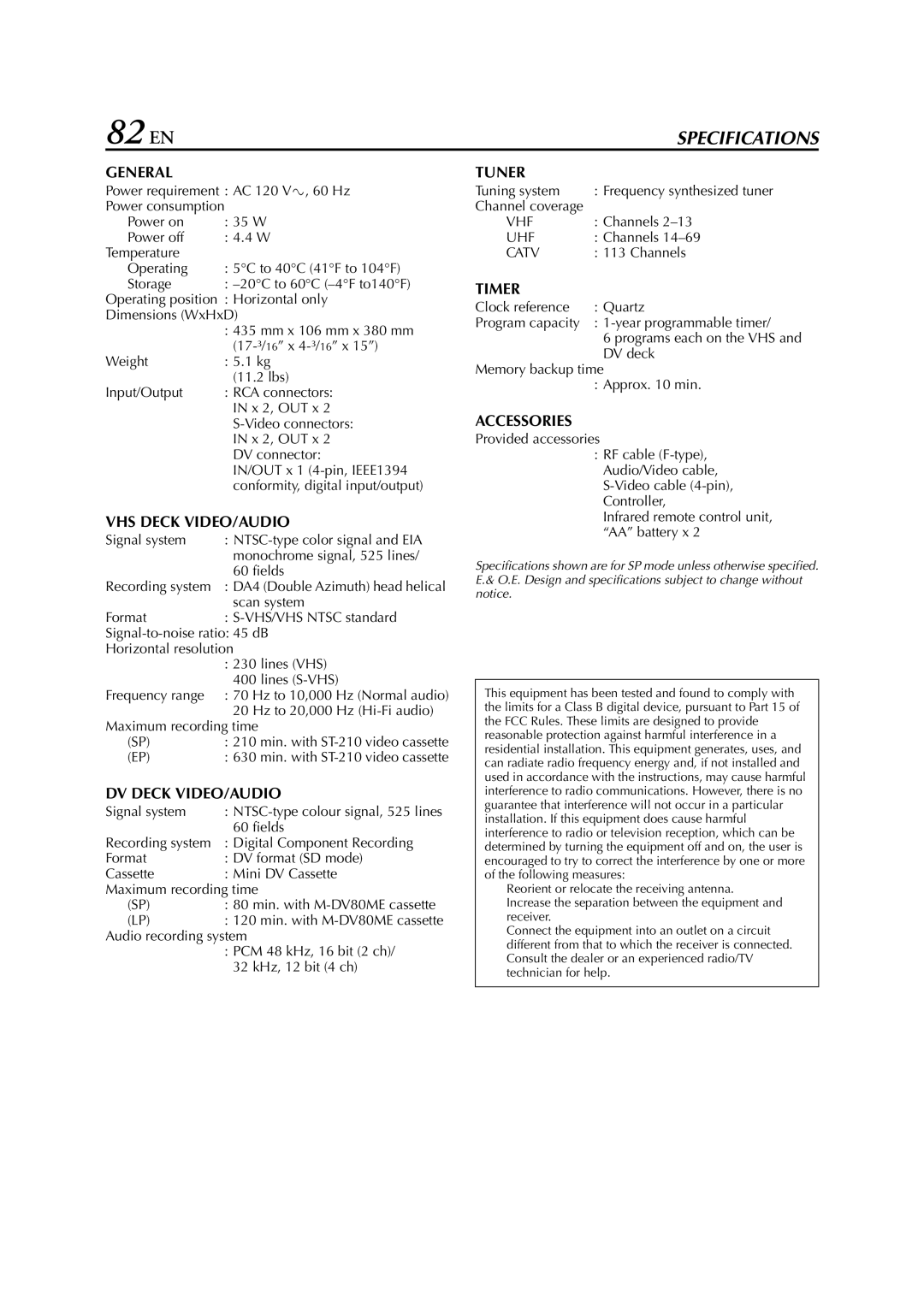
82 EN | SPECIFICATIONS |
GENERAL
Power requirement : AC 120 Vd, 60 Hz
Power consumption
Power on | : 35 W |
Power off | : 4.4 W |
Temperature |
|
Operating | : 5°C to 40°C (41°F to 104°F) |
Storage | : |
Operating position : Horizontal only
Dimensions (WxHxD)
| : 435 mm x 106 mm x 380 mm |
| |
Weight | : 5.1 kg |
| (11.2 lbs) |
Input/Output | : RCA connectors: |
| IN x 2, OUT x 2 |
| |
| IN x 2, OUT x 2 |
| DV connector: |
| IN/OUT x 1 |
| conformity, digital input/output) |
VHS DECK VIDEO/AUDIO
Signal system | : |
| monochrome signal, 525 lines/ |
| 60 fields |
Recording system | : DA4 (Double Azimuth) head helical |
| scan system |
Format | : |
Horizontal resolution
:230 lines (VHS)
400 lines
Frequency range | : 70 | Hz to 10,000 | Hz (Normal audio) |
| 20 | Hz to 20,000 | Hz |
Maximum recording time |
| ||
(SP) | : 210 min. with | ||
(EP) | : 630 min. with | ||
DV DECK VIDEO/AUDIO
Signal system | : |
| 60 fields |
Recording system | : Digital Component Recording |
Format | : DV format (SD mode) |
Cassette | : Mini DV Cassette |
Maximum recording time | |
(SP) | : 80 min. with |
(LP) | : 120 min. with |
Audio recording system
:PCM 48 kHz, 16 bit (2 ch)/ 32 kHz, 12 bit (4 ch)
TUNER
Tuning system | : Frequency synthesized tuner |
Channel coverage |
|
VHF | : Channels |
UHF | : Channels |
CATV | : 113 Channels |
TIMER
Clock reference | : Quartz |
Program capacity | : |
6 programs each on the VHS and DV deck
Memory backup time
: Approx. 10 min.
ACCESSORIES
Provided accessories
:RF cable
Infrared remote control unit, “AA” battery x 2
Specifications shown are for SP mode unless otherwise specified. E.& O.E. Design and specifications subject to change without notice.
This equipment has been tested and found to comply with the limits for a Class B digital device, pursuant to Part 15 of the FCC Rules. These limits are designed to provide reasonable protection against harmful interference in a residential installation. This equipment generates, uses, and can radiate radio frequency energy and, if not installed and used in accordance with the instructions, may cause harmful interference to radio communications. However, there is no guarantee that interference will not occur in a particular installation. If this equipment does cause harmful interference to radio or television reception, which can be determined by turning the equipment off and on, the user is encouraged to try to correct the interference by one or more of the following measures:
Reorient or relocate the receiving antenna. Increase the separation between the equipment and receiver.
Connect the equipment into an outlet on a circuit different from that to which the receiver is connected. Consult the dealer or an experienced radio/TV technician for help.
